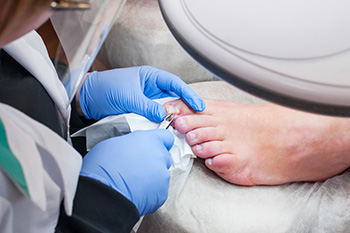
A pincer, or trumpet, toenail is a condition where the sides of the toenail curve inward, creating a pinched appearance. This can lead to pain, discomfort, and in severe cases, the nail may dig into the skin, causing swelling and redness. It commonly affects the big toe and can result from wearing improper footwear, genetics, or trauma. Symptoms include localized pain, redness, and pressure surrounding the nail, especially when wearing shoes or walking. Over time, the condition can worsen, leading to chronic discomfort and even infections, if left untreated. Treatment options for pincer toenails include trimming the nail properly, using padding or orthotics to reduce pressure, and in some cases, surgical correction to reshape the nail. A podiatrist can assess the severity of the condition and recommend the most appropriate treatment, including minor surgery if needed. If you are experiencing this condition, it is suggested that you schedule an appointment with a podiatrist for a thorough evaluation and care.
Ingrown toenails may initially present themselves as a minor discomfort, but they may progress into an infection in the skin without proper treatment. For more information about ingrown toenails, contact one of our podiatrists of Comprehensive Foot & Ankle Centers. Our doctors can provide the care you need to keep you pain-free and on your feet.
Ingrown Toenails
Ingrown toenails are caused when the corner or side of a toenail grows into the soft flesh surrounding it. They often result in redness, swelling, pain, and in some cases, infection. This condition typically affects the big toe and may recur if it is not treated properly.
Causes
- Improper toenail trimming
- Genetics
- Improper shoe fitting
- Injury from pedicures or nail picking
- Abnormal gait
- Poor hygiene
You are more likely to develop an ingrown toenail if you are obese, have diabetes, arthritis, or have any fungal infection in your nails. Additionally, people who have foot or toe deformities are at a higher risk of developing an ingrown toenail.
Symptoms
Some symptoms of ingrown toenails are redness, swelling, and pain. In rare cases, there may be a yellowish drainage coming from the nail.
Treatment
Ignoring an ingrown toenail can have serious complications. Infections of the nail border can progress to a deeper soft-tissue infection, which can then turn into a bone infection. You should always speak with your podiatrist if you suspect you have an ingrown toenail, especially if you have diabetes or poor circulation.
If you have any questions, please feel free to contact our offices located in Shepherdsville and Louisville, KY . We offer the newest diagnostic and treatment technologies for all your foot care needs.
